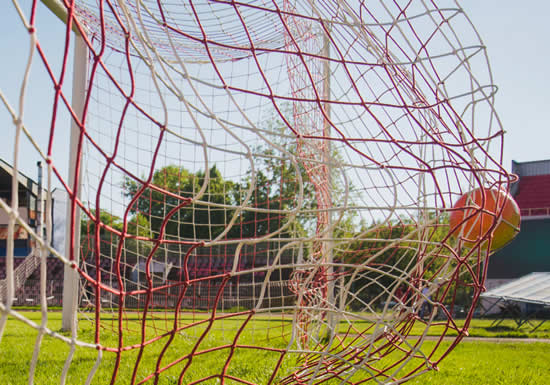Blind Soccer – Rules Overview
- Team Composition
- Each team consists of five players: four outfield players who are blind or visually impaired and one sighted goalkeeper.
- Outfield players wear blindfolds to ensure equal conditions.
- The goalkeeper is restricted to staying within the penalty area.
- Field of Play
- The field measures 40 x 20 meters, smaller than a standard soccer field.
- Boards surround the field to prevent the ball from easily going out of play.
- Ball
- The ball contains rattles or bells, allowing players to track it audibly.
- Communication
- Players call out "Voy" (Spanish for "I’m coming") when approaching the ball or an opponent to avoid collisions.
- The coach stands behind the opposing team’s goal, giving instructions to attacking players.
- The goalkeeper provides defensive guidance and instructions within the penalty area.
- Match Duration
- A match lasts 2 x 20 minutes with a 10-minute halftime break.
- Goalkeeper
- The goalkeeper is sighted but must remain within the goal area.
- They are also responsible for defensive communication.
- Fouls and Free Kicks
- Physical contact is permitted, but excessive use of hands, dangerous actions, or intentional pushing result in free kicks or penalties.
- Free kicks are taken from 6 meters, with defenders maintaining a 3-meter distance.
- Penalty Kicks
- A penalty kick is awarded if a foul occurs within the penalty area, similar to standard soccer.
- Offside Rule
- There is no offside rule in blind soccer.
- Game Start and Continuation
- The game begins and resumes after breaks with a dropped ball by the referee.
Blind soccer requires exceptional concentration and communication, with the auditory aspect of the game playing a critical role in player orientation and match flow.

The History of Blind Soccer
Blind soccer has evolved significantly since its inception, becoming a structured and recognized international sport. Here are the key milestones:
- Early Beginnings
- Blind soccer informally originated in South America during the 1950s. In Brazil, blind and visually impaired individuals began playing soccer with improvised sound-producing balls.
- Similar activities emerged in countries like Spain and Argentina, where soccer was a popular pastime for the blind.
- Development in the 1980s
- The first organized blind soccer tournaments were held in the 1980s, particularly in Brazil, where the sport gained widespread popularity.
- European nations, notably Spain, also began organizing blind soccer activities, becoming pioneers in the sport.
- International Recognition and Standardization (1990s)
- During the 1990s, blind soccer gained international attention, leading to the organization of the first international tournaments and the standardization of rules.
- In 1996, blind soccer was introduced as a demonstration sport at the Paralympic Games.
- In 1997, the International Blind Sports Federation (IBSA) formalized the sport's rules, which were adopted globally.
- Paralympic Games and World Championships (From 2004)
- In 2004, blind soccer was officially included in the Paralympic Games in Athens, marking a major milestone for the sport.
- Since then, it has been a core discipline at the Paralympics.
- The first Blind Soccer World Championship took place in Brazil in 1998, and world championships have been held regularly, featuring teams from across the globe.
- Blind Soccer in Germany and Europe
- The sport expanded across Europe in the 2000s, with Germany launching its Blind Soccer Bundesliga in 2008.
- In 2006, the first European Blind Soccer Championship was held in Germany.
- Countries like Spain, France, and the United Kingdom are now among the strongest nations in blind soccer.
- Modern Developments
- Today, blind soccer is played in over 60 countries worldwide.
- In addition to the Paralympic Games and World Championships, there are numerous international tournaments such as the Copa América and the IBSA World Grand Prix.
- The sport’s popularity continues to grow, with ongoing efforts to improve public awareness and accessibility for players at all levels.